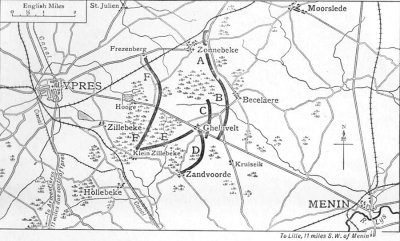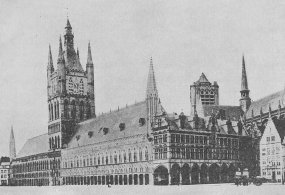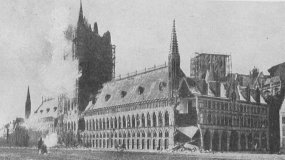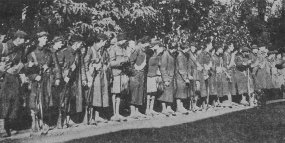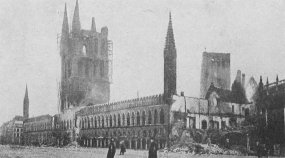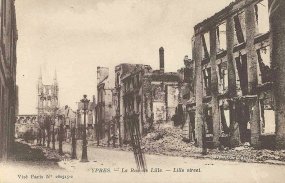
WWII: Maginot Line | Normandy | V-Weapon Sites | Arnhem
Further afield: Crete
| Home Tracing Military Ancestors Travel Advice CWGC Cemeteries Iron Harvest News Book Reviews Glossary Links Contact Me Ypres:
 
|
The First Battle of Ypres (October to November 1914)Following the defeat of the German advance into France at the Battle of the Marne in September 1914, their General Staff ordered a withdrawal to more easily defensible positions north of the river Aisne. It was clear to the Germans that their plan to take Paris in one great blow had failed. It was equally patent to the French and British, as attacks to dislodge the Germans in late September broke down, that each side would need to find an open flank if a war of movement was to be resumed. In what became known as “The Race to the Sea”, both sides began to move troops northward to do just that. On 7th October, German scout cavalry reached the medieval town of Ypres, only miles from the English Channel. Just hours later, British troops arrived to counter them. The Germans retired to the ridges north, east and south of the city to await reinforcements. In so doing they gave birth to the “Salient”. The armies that faced each other in the first two weeks of October were very different. The unification of the German states under Count Otto von Bismark had created an industrial superpower, which dominated Europe. The German Army was gigantic – a mixture of conscripts, professional cadres of NCO’s and officers. Together with trained reserves it numbered over four and a half million on mobilisation, supported by large quantities of modern machine guns and heavy artillery. The British Army, by contrast, was tiny. Secure in her island domain and protected by the Royal Navy (the world’s largest) her total military establishment was little more than 150,000 at the outbreak of war, plus 200,000 reservists and part-time territorials. The only advantage the British had was that theirs was a professional army, trained as expert marksmen following the sobering lessons of the Boer War. On 22nd October, the Germans commenced their onslaught at Langemarck in an attempt to break through to Calais and crush the small British Expeditionary Force (BEF) before them. Many of the German infantry were students straight from regimental depots. Confident in victory they hurled themselves at the BEF only to be slaughtered by the experienced and steadfast British riflemen. On 29th October the Germans tried again – this time along the Menin Road where their greater numbers nearly broke the British line. Only a bayonet charge by the 2nd Worcesters averted disaster. In early November, the Germans made a third concerted grab for Ypres, this time attacking along the whole front. Vicious fighting around Wytschaete on the Messines Ridge saw the village change hands a number of times before it was eventually held by the French XIV Corps. By the end of November, both sides were utterly exhausted and began to dig in.
The Germans had suffered 130,000 casualties, many from the young student battalions sent against the BEF at Langemarck, leading the Germans to refer to 1st Ypres as “The Massacre of the Innocents”. The British had suffered fewer casualties, 58,000, but enough to rip the heart out of their small professional army. Ypres had been saved, but already German heavy guns, ranged in from the high ground were destroying the historic town. By the end of 1914, the great Cloth Hall and Cathedral were already in ruins. The salient had formed and now the great siege began. |
